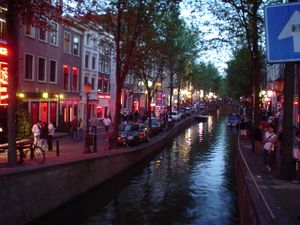Red-light district
|
A red-light district is a neighbourhood where prostitution and other businesses in the sex industry flourish. The term "red-light district" was first recorded in the United States around 1890, and derives from the practice of placing a red light in the window to indicate to customers the nature of the business. The color red has been associated with prostitution for millennia: in the Biblical story of Rahab a prostitute in Jericho aided the spies of Joshua and identified her house with a scarlet rope.
Some say the origin of the red light comes from the red lanterns carried by railway workers, which were left outside brothels when the workers entered, so that they could be quickly located for any needed train movement.
In more recent years the red light district term has its name from the red lights that hang from the district's brothels. [Barbara Mikkelson, "Red Light District", http://www.snopes.com/language/colors/redlight.htm, 12 March 1998] One of the many terms used for a red-light district in Japanese is akasen(赤線}, literally meaning "red-line", apparently of independent origins from the English term. Japanese police drew a red line on maps to indicate the boundaries of legal red-light districts. They also have a term aosen(青線), meaning "blue-line", for a non-legal district. In different cultures red-light districts are identified differently, the most common being "district of prostitutes" (e.g., in Hindi - Randi Guli or Street of Prostitutes; in Bengali - Khanki Para or Neighbourhood of Prostitutes.)
See also
References
- More information is available at [ Wikipedia:Red-light_district ]
Chat rooms • What links here • Copyright info • Contact information • Category:Root
|
Further information might be found in the Discussion/Talk page (see tab above) or at Categories:articles to be expanded. |
